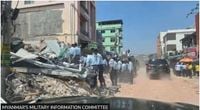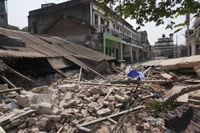Myanmar, a nation long beset by wars and natural disasters, was rocked by a devastating 7.7 magnitude earthquake on March 28, 2025, which has left at least 1,700 people dead and raised fears that the toll could climb significantly higher. The earthquake's impact is compounded by the ongoing civil war that erupted after the military seized power from the elected government of Aung San Suu Kyi in February 2021. The country, formerly known as Burma, has been in a state of conflict for over 75 years, making it one of the longest-running civil wars in the world.
The earthquake struck with ferocity, causing extensive damage and complicating relief efforts in a country already struggling with humanitarian crises. The military government, which has restricted aid to over 3 million people displaced by the ongoing conflict, faces criticism for its handling of the disaster. The army has been accused of using aid as a weapon, controlling the distribution of food and assistance to bolster its power.
In a significant development, the National Unity Government (NUG), a coalition of pro-democracy forces now operating in exile, announced a two-week ceasefire starting March 30, 2025, in areas affected by the quake. This move aims to facilitate humanitarian aid and rescue efforts, though the military has yet to respond to this initiative. The NUG's ceasefire is largely symbolic, as the People's Defense Force (PDF), which is the armed wing of the NUG, primarily engages in defensive operations. However, the gesture allows the resistance to claim the moral high ground in the face of ongoing military repression.
"We will collaborate with the U.N. and international NGOs to ensure security, transportation, and the establishment of temporary rescue and medical camps in the areas we control," the NUG stated in a recent announcement. They also offered to provide healthcare professionals loyal to the resistance to assist international organizations delivering emergency services in military-controlled regions, contingent upon safety guarantees.
Despite the NUG's assurances, skepticism remains about the military government's ability to manage foreign aid effectively. Past experiences have shown that the junta's response to disasters has been inadequate and often delayed. After Cyclone Nargis devastated Myanmar in 2008, the military initially refused to allow foreign rescue teams and imposed severe restrictions on aid. This resulted in over 100,000 deaths, with many more missing. More recently, when Cyclone Mocha struck in May 2023, the military's relief efforts were again criticized for being slow and poorly coordinated, with independent estimates of the death toll exceeding official figures.
As rescue teams from various countries mobilize to assist in the aftermath of the earthquake, the situation remains dire. The full extent of casualties is difficult to ascertain due to poor access to affected areas and restrictions on foreign media. The challenges of reporting from Myanmar are compounded by the military's control over information and the ongoing conflict, which has made it hard to get accurate assessments of the damage.
In neighboring Thailand, the earthquake's tremors caused a tall building under construction in Bangkok to collapse, resulting in at least 18 deaths and 76 workers still missing as rescue efforts continue. Signs of life have been detected under the rubble, and families are anxiously waiting for news of their loved ones. One woman expressed her determination to wait “for as long as it takes” to hear from her missing family member.
The international community is watching closely as the situation unfolds in Myanmar. The NUG's ceasefire and willingness to cooperate with humanitarian organizations could pave the way for much-needed assistance to reach those affected by the earthquake. However, the military's track record raises serious concerns about the equitable distribution of aid and the safety of those attempting to provide it.
Amidst the chaos, there are examples from other countries where rebuilding efforts after natural disasters have contributed to peace in conflict-ridden areas. The recovery in Indonesia's Aceh province after the 2004 Indian Ocean tsunami serves as a hopeful reminder of the potential for collaboration and healing in the wake of tragedy.
As Myanmar grapples with the aftermath of this earthquake, the intersection of natural disaster and human conflict presents a complex challenge. The need for humanitarian assistance is urgent, and the response from both the military government and the resistance will be crucial in determining the fate of thousands affected by this calamity.
In a nation where the scars of war run deep, the earthquake has further complicated an already dire humanitarian situation. The coming weeks will be critical as the world watches how Myanmar navigates the dual crises of natural disaster and civil conflict, and whether the ceasefire will lead to meaningful aid distribution or merely serve as a temporary pause in hostilities.





